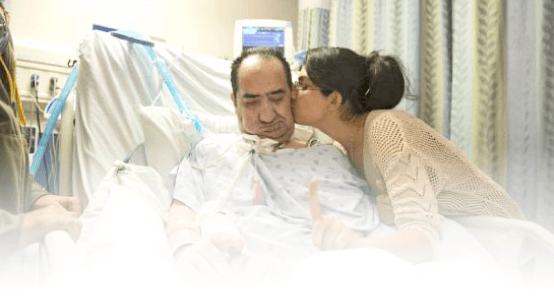Podcast: Play in new window | Download
Subscribe: Apple Podcasts | RSS
Hi, it’s Patrik Hutzel from INTENSIVECAREHOTLINE.COM where we instantly improve the lives for Families of critically ill Patients in Intensive Care, so that you can make informed decisions, have PEACE OF MIND, real power, real control and so that you can influence decision making fast, even if you’re not a doctor or a nurse in Intensive Care!
This is another episode of “YOUR QUESTIONS ANSWERED“ and in last week’s episode I answered another question from our readers and the question last week was
You can check out last week’s episode by clicking on the link here.
In this week’s episode of “YOUR QUESTIONS ANSWERED“, I want to answer another frequently asked question from our readers
How to wean a critically ill Patient in Intensive Care off the ventilator and the breathing tube!
Many critically ill Patients in Intensive Care are on a mechanical ventilator and a breathing tube.
They eventually will need to be weaned off the ventilator and the breathing tube.
Many families of critically ill Patients in Intensive Care therefore want to know how their loved one can be weaned off the ventilator and what the right steps are.
First of all, most critically ill Patients in Intensive Care that require mechanical ventilation and a breathing tube are also induced into an artificial coma.
Mechanical ventilation and a breathing tube can only be tolerated in an induced coma, because it’s too uncomfortable and it’s too painful to be awake during mechanical ventilation with a breathing tube.
Furthermore, most critically ill Patients simply need to rest when they are faced with a critical illness and an induced coma is helping them to do that.
Related article/video
Once your critically ill loved one is on a ventilator, a breathing tube and in an induced coma there comes a time when your loved one needs to be “woken up” and they need to be weaned off the ventilator.
Taking your loved one off the ventilator and removing the breathing tube is called extubation.
What are the steps for weaning off the ventilator and removing the breathing tube?
The steps to wean your loved one off the ventilator and the breathing tube are generally speaking as follows
- Initially when your critically ill loved one is still in an induced coma, they will most likely be in a controlled or assisted ventilation mode like SIMV or A/C which delivers mandatory breaths per minute
- The goal generally speaking is to reduce the sedation and opiates(=pain killers”), to gradually wake up your loved one after the induced coma so that they are in a position to take breaths by themselves and therefore reduce the mandatory breaths/minute
- As your critically ill loved one is waking up more and more and sedation and opiates(=pain killers) are gradually reduced, your loved one should be able to take breaths with minimal support eventually. Therefore, mandatory breaths need to be weaned down to zero and all the effort to breathe needs to come from (“triggered”) your loved one before they can be taken off the ventilator. Your loved one needs to be able to breathe at a sustainable rate/minute, around 10-30 minute
- On top of breathing at a “normal” respiratory rate, your loved one needs to breathe adequate and physiological tidal volumes(TV) and minute volumes(MV). Tidal volumes are usually calculated around your loved one’s weight or 7-10 mls/kg/breaths. Minute volumes are calculated by breaths/minute x tidal volumes
- Other parameters that need to be reduced to a minimum on the ventilator are “Pressure support”, “PEEP”(= positive end expiratory pressure) and oxygen(FIO2). Pressure support is usually weaned down to 8-10, PEEP usually down to +5 and FIO2 is reduced to 30-40% or less
- Your loved one also needs to be awake and they need to be able to follow simple instructions like squeezing fingers, wiggling toes and/or poke out their tongue. They also need a good strong cough to be able to protect their airway once off the ventilator
- Other parameters that need to be looked at are ABG’s(= Arterial blood gases). Oxygen(PO2) levels and Carbon dioxide(PCO2) levels in the ABG’s need to be adequate and within physiological levels
- Physiological levels in the ABG that need to be achieved are PO2>65 mmHg and PCO2 30-45 mmHg. Other parameters that are important is oxygen Saturation >92%
- Some Intensive Care Units may do a weaning trial on a T-piece, which basically takes your loved one off the ventilator and they connect humidified oxygen to the ventilator, but in essence your loved one is breathing without the ventilator. If your loved one can breathe normally and all the parameters above are normal and physiological and your loved one can follow commands they should be ready to be extubated!
- Other issues that may come up at times is that there is airway swelling/obstruction. It means that the airway is swollen and once the breathing tube is removed the airway might be narrowed to the point that breathing is impossible without the breathing tube. This can be tested by taking the cuff down. The cuff is an air balloon that blocks the trachea(windpipe) and blocks air from escaping and also protects the lungs from any potential aspiration that could cause Pneumonia. If airway swelling is present and there is evidence that extubation might cause a block of the airway due to narrowing from swelling the breathing tube needs to stay in. Treatment for airway swelling can be steroids, Adrenaline nebulizers
If your loved one needs prolonged mechanical ventilation and the breathing tube can’t be removed, the next step might be to perform a tracheostomy.

Here are some articles and videos that will educate you when to do a tracheostomy
A tracheostomy is often the next step if your loved one can’t be weaned off the ventilator and the breathing tube.
At the same time, maximizing chances to get off the ventilator and the breathing tube should be paramount.
This includes Physical Therapy or Physiotherapy.
Another option after extubation is to use Non-invasive(Mask) or BIPAP/CPAP ventilation. You can find more information here
https://intensivecarehotline.com/bipap/
What can also happen after an induced coma is that there’s a delay in “waking up” after an induced coma and therefore extubation gets delayed.
If your critically ill loved one can’t come off the ventilator because they are not “waking up” after an induced coma, have a look at those articles and videos here
Also, if the Intensive Care team is referring to a “one-way extubation”, which is basically a “sink” or “swim” approach for your loved one to live or die once the breathing tube is removed and you don’t agree with this approach you have to take a different approach.
A “one-way extubation” basically means that if your loved one can’t breathe without the ventilator and the breathing tube they in essence may die.
You may want to look at the following articles and videos for more information
Your friend
Patrik
How can you become the best advocate for your critically ill loved one, make informed decisions, get peace of mind, control, power and influence quickly, whilst your loved one is critically ill in Intensive Care?
You get to that all important feeling of making informed decisions, get PEACE OF MIND, CONTROL, POWER AND INFLUENCE when you download your FREE “INSTANT IMPACT” report NOW by entering your email below!
In Your FREE “INSTANT IMPACT” report you’ll learn quickly how to make informed decisions, get PEACE OF MIND, real power and real control and how you can influence decision making fast, whilst your loved one is critically ill in Intensive Care! Your FREE “INSTANT IMPACT” Report gives you in-depth insight that you must know whilst your loved one is critically ill or is even dying in Intensive Care!
Sign up and download your FREE “INSTANT IMPACT” REPORT now by entering your email below! In your FREE “INSTANT IMPACT” REPORT you’ll learn how to speak the “secret” Intensive Care language so that the doctors and the nurses know straight away that you are an insider and that you know and understand what’s really happening in Intensive Care! In your FREE report you’ll also discover
- How to ask the doctors and the nurses the right questions
- Discover the many competing interests in Intensive Care and how your critically ill loved one’s treatment may depend on those competing interests
- How to eliminate fear, frustration, stress, struggle and vulnerability even if your loved one is dying
- 5 mind blowing tips& strategies helping you to get on the right path to making informed decisions, get PEACE OF MIND, control, power and influence in your situation
- You’ll get real world examples that you can easily adapt to your and your critically ill loved one’s situation
- How to stop being intimidated by the Intensive Care team and how you will be seen as equals
- You’ll get crucial ‘behind the scenes’ insight so that you know and understand what is really happening in Intensive Care
- How you need to manage doctors and nurses in Intensive Care (it’s not what you think)
Thank you for tuning into this week’s YOUR QUESTIONS ANSWERED episode and I’ll see you again in another update next week!
Make sure you also check out our “blog” section for more tips and strategies or send me an email to [email protected] with your questions!
Or you can call us! Find phone numbers on our contact tab.
Also check out our Ebook section where you get more Ebooks, Videos and Audio recordings and where you can also get 1:1 counselling/consulting with me via Skype, over the phone or via email by clicking on the products tab!
This is Patrik Hutzel from INTENSIVECAREHOTLINE.COM and I’ll see you again next week with another update!



